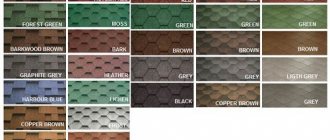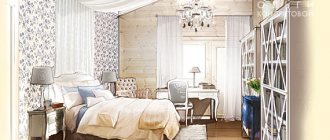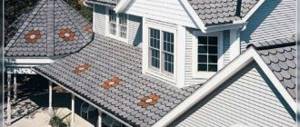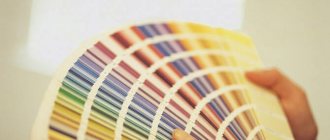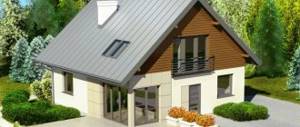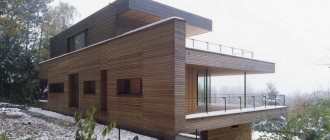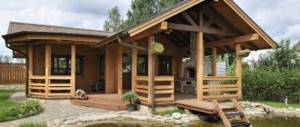Metal tiles
Metal tiles (photo No. 2)
How it is made
Metal tiles are profiled sheets of thin sheet metal. They can be steel, copper or aluminum.
The sheet is covered with a protective coating, most often zinc or aluminum-zinc, but other types of coatings can also be used. This layer protects against corrosion, increases the strength and service life of the material.
The metal tiles are also covered with a protective and decorative polymer coating:
- Polyester
- Acrylate
- Polyurethane
This coating gives the material color and texture, and also protects against external influences: ultraviolet rays and corrosion.
Structure of metal tiles (photo No. 3)
The weight of metal tiles is 4–7 kg/m2.
Advantages of metal tiles
- Large selection of texture, color and profile options
- A light weight. Simplifies the installation of metal tiles; there is no need to strengthen the rafter system
- Reliable corrosion protection. A protective coating made of zinc and aluminum alloys copes well with this task
- Long service life - up to 50 years or more
- Simple installation technology: you can do all the work yourself. A metal roof is also easy to repair.
- You can lay metal tiles even in winter (at sub-zero temperatures)
Disadvantages of metal tiles
- Poor sound insulation. During strong winds, rain or hail, the attic will be noisy
- On complex roofs there may be increased material consumption
- If the protective coating is damaged or insufficiently thick, there is a risk of corrosion.
- High thermal conductivity
!
Note!
When installing metal tiles, it is important to use high-quality seals for self-tapping screws. Poor quality seals deform over time and the roof begins to leak.
Protective coatings for metal tiles
To increase durability, the base metal sheets are coated with special protective coatings.
The most budget option is a coating made of standard polyester
25 microns thick. Despite the low price and large selection of colors, this coating is the least resistant to fading and various damages. But its low cost makes it a fairly popular choice.
The thicker coating is made of matte polyester
. Metal tiles with such a protective coating are most similar to ordinary ceramic tiles. Its service life is longer due to the greater thickness of the coating (35 microns).
Pural
- This is a type of coating based on polyurethane. Its distinctive feature is its very high resistance to solar radiation, which allows it to maintain its original color for many years and effectively resist fading. The thickness of a covering made of pural is twice the thickness of a covering made of standard polyester, but metal tiles with such a coating are also more expensive.
PVDF
– modern coating based on polyvinyl fluoride. Despite its small thickness, it is one of the most resistant coatings today. Metal tiles coated with polyvinyl fluoride will last a very long time, but will not be cheap.
There is another type of coating - plastisol
, having a large thickness (200-250 microns) and excellent resistance to mechanical damage.
The main characteristics of metal tile coatings are presented in the table below:
| Name of coating | Coating thickness | Mechanical stability | Color fastness | Metal tile price |
| Polyester (PE, polyester) | ||||
| Matt polyester (PEMA, Matt PE) | ||||
| From $10/sq.m | ||||
| P50 (PUR/Prelaq Nova, SSAB) | From $10/sq.m | |||
| Plastisol (P200, PVC, HPS-200) | excellent | From $10-12/sq.m | ||
| excellent | From $15/sq.m |
Ceramic tiles
Ceramic tiles (photo No. 4)
How it is made
Ceramic tiles are a roofing material made from pottery's fusible clay. There are two main production technologies:
- Tape method. A ribbon is made from clay, which is then cut into individual pieces. Tiles produced using this technology have grooves along the tiles.
- Stamping. For this method, special metal molds are used, in which the clay is pressed and blanks of the desired shape are obtained. With this technology, the tiles receive grooves on both sides of the finished tile.
Production of ceramic tiles (photo No. 5)
After the clay has received the desired shape, the blanks go through:
- Drying
- Application of protective coating
- Firing at temperatures over 1000 °C
Ceramic tiles are the heaviest material listed. Its weight is approximately 50 kg/m2.
Advantages of ceramic tiles
- Resistance to high and low temperatures
- Not afraid of exposure to ultraviolet rays
- Not afraid of bacteria and microorganisms
- Slowly heats up and cools down. A good option for houses with an attic
- Heavy weight. Heavy-duty ceramic tile roofing can withstand strong gusts of wind, heavy rain and hail. At the same time, it provides good noise protection
- Durability. Can last for more than 80 years without repair
- Minimum roofing maintenance costs
- Great looks
Disadvantages of ceramic tiles
- Heavy weight. Although we consider this characteristic to be an advantage, there is also a downside. When installing ceramic tiles, you should be sure that the rafters are designed for a load of at least 200–250 kg/m2.
- Low tightness. Between the joints of the tiles, rain or snow may enter the under-roof space. This problem can be easily solved by waterproofing the roof.
- The tiles are quite fragile. Therefore, they must be handled with care during transportation and installation.
- High price
!
Which tiles are best for the roof of a private house?
If your budget allows, it is better to use natural tiles (for example, ceramic). This is a high-quality and reliable material that looks great on a private home.
Calculation of metal roof tiles
As a rule, the width of a metal tile sheet is 10 cm larger than the working surface, therefore, to accurately calculate the number of sheets, it is necessary to calculate the exact parameters of the roof. The calculation is carried out on a horizontal slope. The formula for calculation is simple - the length of the sheet is simply divided by the width, after which the resulting figure is rounded. In this case, the length of the slope is taken into account, a 15-centimeter overlap in length is added, a cornice overhang is added, about 15 cm, but if the sheets are laid end-to-end, then the overlap is not taken into account. As a result, the required sheet length is obtained. Accurate calculations will reduce the amount of waste and increase the economic profitability of the construction site as a whole.
Composite tiles
Composite tiles (photo No. 6)
How it is made
Composite tiles are a multilayer roofing material. It is based on steel sheets, which give the sheets a relief shape
- Steel sheets are coated on both sides with a special anti-corrosion coating.
- The next layer of coating is a primer, applied on both sides. From below, this coating protects the anti-corrosion layer from mechanical damage and negative influences of the external environment. On top - improves the adhesion of the base of the sheet with another layer, decorative.
- The decorative layer is an acrylic composition + mineral powder coating.
The acrylic composition gives the tiles a base color and protects them from ultraviolet radiation. A layer of mineral powder is poured onto the acrylic coating. Most often these are basalt chips or small chips of other rocks. The mineral coating performs a decorative function and provides sound insulation of the roof. - Acrylic glaze. The final layer that protects the mineral coating from moisture and wind. This layer is resistant to temperature changes and has self-cleaning properties.
The structure of composite tiles (photo No. 7)
On average, the weight of composite tiles is 6-6.5 kg/m2.
A must-have tool for any installation work. Using a tape measure, you will need to measure the required length of the panel before cutting and laying.
Advantages of composite tiles
- Light weight. There is no need to reinforce the rafter system under a composite roofing tile. This simplifies the roofing technology and eliminates the need for additional costs.
- Thanks to the light weight of the material, installation is faster and easier. Sheets of composite shingles can be lifted manually.
- Reliability and durability. This roof is protected from corrosion, chemical and mechanical influence. Withstands snow loads.
- Retains color. UV resistance provides protection against fading.
- Service life is at least 30-50 years.
- Low thermal conductivity. A comfortable microclimate is maintained in the under-roof rooms both in winter and summer.
- Fire safety. Such tiles do not burn and do not emit toxic substances.
- Good sound insulation is a useful characteristic for attics.
- Environmentally friendly material.
Disadvantages of composite tiles
- Low vapor permeability. When arranging the roof, it is necessary to ensure good ventilation.
- Difficult to care for. The material is plastic, so you need to be careful when moving on the roofing deck.
- Price and cost of installation work. You can save on installation if you do the installation yourself.
How to choose the color of tiles
To accurately calculate metal tiles, you need to know the dimensions of an individual element and the type of profile. Next, the exact dimensions of the roof slopes are determined, and if necessary, all decorative elements in the structure are taken into account.
In the case of a complex design, a complete layout is first made on paper, where all dimensions are precisely indicated.
Metal tiles come in different colors. It is preferable to choose a neutral color for the roof, not too dark and not too light.
This is due to the following reasons:
- Dark tiles heat up under the scorching rays of the sun, causing the attic or attic to become very hot.
- If the house is made of light-colored material, then a dark roof will not go well with it.
- Light-colored tiles do not heat up as much, but any dirt is very visible on them. It doesn’t go well with a house whose walls are made of dark material, but it looks great with pink and beige walls.
The material in neutral tones harmonizes perfectly with any wall color.
A roof made of green roofing material is associated with nature, with green foliage and grass. The rich color of the roof sets a person up for a calm lifestyle. Muted green shades make a person more attentive and focused. Psychologists recommend using this color everywhere.
Brown metal tiles are also often used for roof installation. This color gives self-confidence and helps to overcome various difficulties. This color is conservative. When decorating houses, a combination of brown and dark brown metal tiles is often used. If the house is located among tall trees, then a brown roof among green foliage will look just great.
A blue roof looks great during daylight hours and in bright places, so you can arrange evening lighting in the yard. Blue color helps to relax and calm down, however, too dark shades, on the contrary, contribute to depression. That is why the material comes in blue and light blue colors, which look like neutrals.
The burgundy-red color of the roof symbolizes the elements of energy, movement, and the will to win. This color promotes mental and physical activity, which is why many successful and active individuals choose it. The most popular shade of red in roof coverings is wine red. This roofing in combination with related shades is the ideal solution.
Among the light shades of roofing, gray is considered the most successful. It looks ideal in a shaded area, such as among trees. The gray color goes well with the colors of natural nature, and also symbolizes stability and a restrained disposition. This color is chosen for their roof by people who purposefully move towards their goal.
Dark colors of metal tiles contribute to fading of the roof in the sun. If it is of high quality, then it will lighten evenly. A low-quality roof will burn out very quickly.
We suggest you read: Which side is the vapor barrier placed on the roof?
When arranging a roof, experts pay serious attention to the choice of roofing material, among which metal tiles are considered one of the best coverings. At the same time, the color of metal tiles is important for several reasons.
A modern roofing covering of any structure should help create an attractive appearance, regardless of how much time has passed since the installation work. Metal tile sheets are produced not only by well-known foreign, but also by progressive domestic companies.
A competent choice of color combination of metal roofing tiles, the façade of the building and the drainage system makes it possible to give the building an organic and perfect appearance.
Metal tiles Grand Line ® are made of hot-dip galvanized steel with a colored polymer coating.
- polyester coating is sold in accordance with the catalogue: RAL – 24 shades and RR – 4 shades;
- Granite®HDX coating is available in RAL – 4 shades and RR – 4 shades;
- plastisol coating is available in 7 colors;
- Velur® coating is available in RAL - 4 shades;
- double-sided polyester coating presented in RAL - 3 shades;
- Colority Print coating is available in 6 colors.
The Metal Profile metal tile catalog includes 23 colors according to RAL, P 362 and 363, 4 shades according to RR and 7 metallic shades.
RUUKKI metal tile roofing is produced in Finland. The product catalog contains an extensive and varied range of colors, represented by more than twenty RR shades.
The color palette of metal roofing tiles from most major manufacturers of such
Andalusia luxury two-step
The material has a fairly wide range and represents more than fifty color options according to the RAL standard.
- Monterrey. The standard color palette includes forty different shades, and upon request, roofing sheets can be painted in any color.
- Supermonterrey. The rich color range allows you to choose almost any shade, but the most popular colors are chocolate, brown and green, as well as shades of red wine, moss green and ultramarine.
- Cascade. The colors of this metal tile are very varied (RAL 24 shades) and are distinguished by the presence of smooth smoky transitions.
- Andalusia. The modern type of metal tiles is characterized by the application of paint and polymer coatings of various shades, corresponding to GOST 30246-94.
- Venice. The Prelaq X-Matt coating guarantees the shade stability of metal roofing tiles, regardless of the source material, and has a 100% color match.
The most resistant to fading are Matte Pural and Prisma coatings. PVDF and Solano. These same coatings are characterized by resistance to corrosive changes. In addition, Solano, Plastisol and Purex coatings are practically immune to mechanical damage. Matte and Glossy Polyester coatings have average indicators for all characteristics.
Length of service life of the roofing covering based on the characteristics of the covering:
- Glossy Polyester – ten years;
- Matte Polyester – fifteen years;
- Prisma - twenty years;
- Plastisol - thirty years;
- PVDF – thirty-five years;
- Purex - forty years;
- Matt Pural and Pural - fifty years;
- Solano – seventy years old.
The highest quality, but also the most expensive polymer coating is Solano, which is distinguished by its original texture with dot embossing. A rich range of colors allows you to choose the best option for metal roofing tiles and additional elements. It should be borne in mind that a computer screen may produce a certain color distortion, and that is why it is recommended to make the final choice of color at the place where the metal tiles were purchased.
To determine how many sheets of thematic building material will be needed to cover the sheathing, you must be guided by:
- Shape and area of the future roof;
- The number of additional elements (ridge, aerator, valley, etc.);
- Length, height, slope angles.
- Profile type directly for the tiles;
- The number of sheets in one row.
After this, all that remains is to calculate the metal tiles and add another 5% to the resulting volume, so that possible damage or defective sheets during construction do not seem like a disaster and can be easily resolved by replacing them with another building material of the same series.
PDPV coating
Bituminous shingles
Bituminous (or flexible) tiles Alta-Profile (photo No. 9)
How it is made
Bitumen shingles are one of the most popular types of soft roofing. This material is based on a dense fiberglass sheet, which is impregnated with high-quality bitumen with polymer additives. The following types of bitumen can be used:
- SBS-modified bitumen - with the addition of artificial rubber. This additive increases the elasticity of bitumen, resistance to severe frosts and high temperatures, as well as ultraviolet rays.
- Oxidized bitumen (enriched with oxygen). This bitumen is less flexible, but cheaper.
The top of the canvas is covered with fine-grained topping made of natural slate or basalt. Powder functions:
- Protects bitumen from ultraviolet radiation and strong heat (prevents bitumen from melting)
- Protects coatings from mechanical damage - birds, tree branches, hail, snow, etc.
- Increases strength
- Shapes the appearance - there are many options for color shades of the coating
The weight of bitumen shingles is from 6 to 15 kg/m2.
Advantages of bituminous shingles
Advantages of Alta-Profile tiles (photo No. 10)
- The warranty, depending on the manufacturer, ranges from 20 to 50 years.
- Suitable for installation of complex roofs. There is virtually no waste left during installation.
- Excellent sound insulation. Reduces noise from rain and hail.
- Fire resistance. The material does not burn well and does not ignite.
- Light weight. There is no need to strengthen the rafter structure.
- Large selection of shades
- The material is light and compact - easy to transport.
Disadvantages of bitumen shingles
- When laying bitumen shingles, a base of the underlying layer is required. This slightly increases the cost and scope of work.
- If the roof slope is less than 13 °, you need to use an additional underlay to protect the roof from moisture.
- Softens at high temperatures. It is not recommended to install bitumen shingles in hot weather. Also, in extreme heat, you should not move on such a roof.
- If the coating is damaged, it is difficult to make a partial replacement.
- Light weight. There is no need to strengthen the rafter structure.
- Large selection of shades
- The material is light and compact - easy to transport.
The underlying layer for flexible tiles from Alta-Profil (photo No. 11)
Which metal tile is better?
When choosing a metal tile, you should pay attention to its appearance, the thickness of the metal and the type of polymer coating.
The color of metal tiles should be selected in accordance with the general color scheme of the building site and neighboring buildings. Most often, colors close to the color of ceramic tiles are chosen, dark brown; colors of greenish shades to match the surrounding greenery of the trees are also in demand. Otherwise, the roof will literally be an eyesore, standing out too much from the surrounding color scheme.
If you live in an area where there is a lot of snow in winter, then for greater roof strength you should choose metal tiles made from a metal sheet with a thickness of at least 0.5 mm.
Depending on the intensity of atmospheric influences, you should choose the type of polymer coating. If your site is located in the middle zone, where there is no scorching heat of the sun in summer, and winter is not characterized by bitter frosts, then you can choose standard polyester, which will allow you to significantly save on the purchase of metal tiles.
If you live in an area with a significant temperature difference, or on the sea coast, where the air is saturated with sea water vapor containing substances that are aggressive to building materials, then a higher degree of protection is needed. In this case, it is worth taking a closer look at metal tiles coated with plastoisol, pural or polyvinyl fluoride.
When purchasing metal tiles, do not hesitate to ask for a quality certificate. This will help protect you from purchasing products from unknown companies of dubious quality.
Now you know enough to navigate the building materials store when purchasing metal tiles.
In the next publication we will learn about corrugated sheets (corrugated sheets) - we will consider the types of corrugated sheets, find out its main characteristics, understand what its marking means and get acquainted with the most popular brands of wall and roofing corrugated sheets produced by the industry.
Externally similar to natural tiles, but lighter and cheaper, metal tiles have become one of the most popular roofing materials. It is used for arranging the roofs of private and multi-storey buildings, industrial buildings and retail facilities. High demand is explained by unique performance qualities
, excellent appearance, a wide variety of textures and colors.
When choosing metal tiles for a roof, you need to take into account a lot of factors
: from sheet thickness and type of protective coating to shade and profile shape. The name of the manufacturer also plays an important role.
Important factors when choosing roofing tiles
Before choosing tiles for your roof, it is important to consider:
- Material service life and warranty period.
The longer the better. - Installation features.
To install some types of tiles, you will need the help of specialists. And these are additional costs. - The weight of the tiles and the technical characteristics of the building.
It should be remembered that the roofing is an additional load on the floors and foundation. And some types of tiles are quite heavy and the load is significant. Therefore, ceramic tiles, for example, should not be used when arranging the roof of a relatively light wooden house. - Climate.
The shingles must be designed for use in your climate region. - Price.
When calculating the cost of roofing, you need to take into account not only the cost of the tiles, but also the installation devices, as well as the installation work itself.
!
Don't chase too low a price. The quality of the roofing directly determines how long the entire roof will last and the comfort in the house.
Metal tile profile
All types of metal tiles differ not only in the base material and protective coating, but also in the shape and height of the profile. Its rigidity directly depends on the profile, which is important when installing a roof in areas with high snow cover. The higher the profile, the stronger the roof will be.
The most common profile is 40-45 mm high. The most common profile shape is the S-shaped profile. The popular types “Andalusia” and “Monterrey” have this shape.
Also quite popular are profiles such as Modern, Cascade, Joker, Banga, Shanghai. They all differ from each other in height and pitch, on which the appearance of the roof depends.
What each of these types of metal tiles looks like is shown in the figures below:
Production and types of metal tiles
A profile sheet of galvanized metal of various compositions is sometimes called metal tiles or corrugated sheets, but there is no guarantee that after some time scrap metal or similar sheet roofing materials will not appear. They may look, as can be seen from the photo, differently, but the essence remains the same for all. Metal tiles are simply distinguished by their profile and pattern, visually similar to natural tiles, which are more familiar and familiar to the average developer, but in essence remain roofing tin coated with a layer of polymer.
However, it is precisely thanks to its shape that metal tiles have a number of unique properties characteristic only of it:
- easy installation on the rafter system;
- a huge selection of colors, textures and profiles;
- relative environmental safety;
- flexibility and elasticity - you can cover the roof of more complex configurations;
- a huge range of prices - from the most budget to the elite.
Despite the great visual diversity, tin sheets remain tin sheets, and types of metal tiles are formed according to profile size, decorative design and color. Therefore, there is no point in considering blue metal tiles separately from metal profiles of a classic color.
No. 7. Metal tile profile type
Along with the shade, the type of profile also affects the perception of metal tiles. The height, pitch and waveform may vary. Manufacturers produce metal tiles with the following main types of profiles:
- Monterrey. Such metal tiles strongly resemble natural clay tiles, have a smoothly rounded profile, and have gained the highest popularity;
- Andalusia. The profile has a wave shape, its main feature is the ability to be secured in a hidden way due to the presence of special locks;
- Shanghai. It is distinguished by a high profile, the presence of waves and several grooves, it looks interesting and unusual, and has been used in the domestic space quite recently.
No. 1. Features of metal tile production
The basis for the manufacture of metal tiles can be one of the following materials:
- steel sheet;
- aluminum sheet;
- copper sheet.
The most commonly used is galvanized steel.
, which, thanks to stamping, is given a certain profile that imitates.
A phosphate layer
can be used on top of the protective zinc layer , which increases corrosion resistance.
The next layer is a primer
, which improves adhesion to the polymer-decorative coating.
The back side
is also galvanized and additionally protected with a layer of transparent varnish, which prevents minor scratches. The thickness of the steel sheet determines the strength of the material, and the type of polymer coating determines how long it will retain its original appearance and resistance to negative environmental factors.
Aluminum sheet
can do without an anti-corrosion coating, but an additional protective polymer layer is still used, because it increases the strength and durability of the material. Aluminum tiles are lightweight, which simplifies transportation and installation, but they do not have many color options, and they are more expensive than their steel counterparts.
Metal tiles made of copper sheet
it is very expensive, it is rarely used, but it looks excellent, and the appearance only improves over time, because a touch of greenish patina appears. It also protects the material from negative factors, so no additional protective materials are used. You can see such tiles on some old houses.
Since metal tiles made of galvanized steel are most widespread, then we will discuss this material further.
